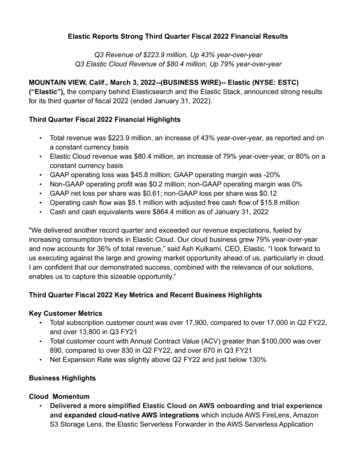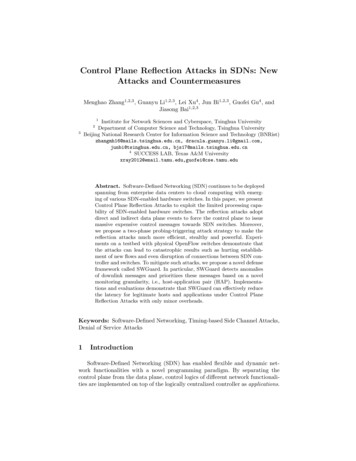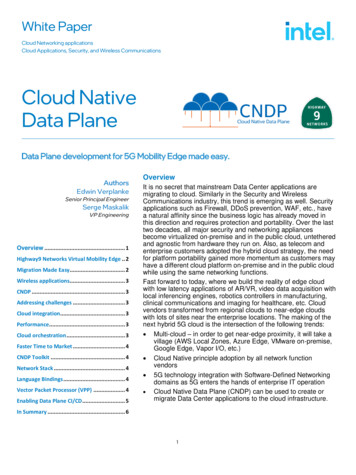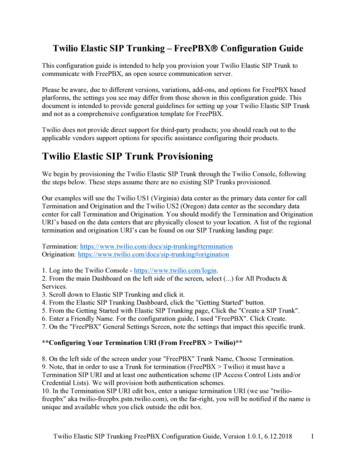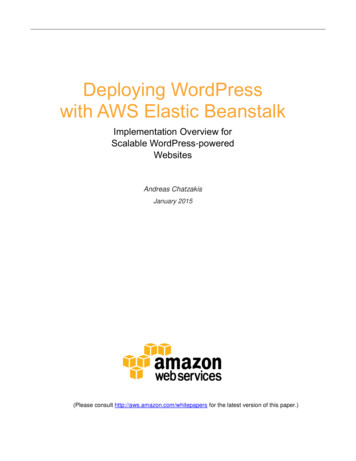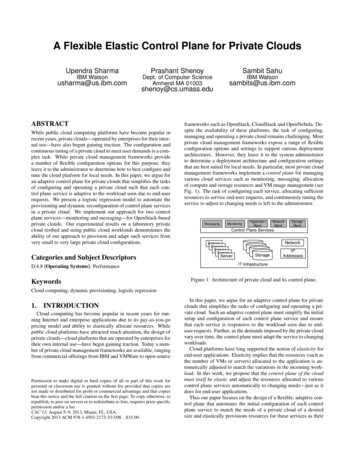
Transcription
A Flexible Elastic Control Plane for Private CloudsUpendra SharmaPrashant ShenoySambit SahuIBM WatsonDept. of Computer ScienceAmherst MA .umass.eduABSTRACTWhile public cloud computing platforms have become popular inrecent years, private clouds—operated by enterprises for their internal use—have also begun gaining traction. The configuration andcontinuous tuning of a private cloud to meet user demands is a complex task. While private cloud management frameworks providea number of flexible configuration options for this purpose, theyleave it to the administrator to determine how to best configure andtune the cloud platform for local needs. In this paper, we argue foran adaptive control plane for private clouds that simplifies the tasksof configuring and operating a private cloud such that each control plane service is adaptive to the workload seen due to end-userrequests. We present a logistic regression model to automate theprovisioning and dynamic reconfiguration of control plane servicesin a private cloud. We implement our approach for two controlplane services—monitoring and messaging—for OpenStack-basedprivate clouds. Our experimental results on a laboratory privatecloud testbed and using public cloud workloads demonstrates theability of our approach to provision and adapt such services fromvery small to very large private cloud configurations.Categories and Subject DescriptorsD.4.8 [Operating Systems]: PerformanceKeywordsIBM Watsonframeworks such as OpenStack, CloudStack and OpenNebula. Despite the availability of these platforms, the task of configuring,managing and operating a private cloud remains challenging. Mostprivate cloud management frameworks expose a range of flexibleconfiguration options and settings to support various deploymentarchitectures. However, they leave it to the system administratorto determine a deployment architecture and configuration settingsthat are best suited for local needs. In particular, most private cloudmanagement frameworks implement a control plane for managingvarious cloud services such as monitoring, messaging, allocationof compute and storage resources and VM image management (seeFig. 1). The task of configuring each service, allocating sufficientresources to service end-user requests, and continuously tuning theservice to adjust to changing needs is left to the workMgmtStorageMgmtControl Plane geStorageStorageNetworkIPAddressesIT InfrastructureFigure 1: Architecture of private cloud and its control plane.Cloud computing, dynamic provisioning, logistic regression1.INTRODUCTIONCloud computing has become popular in recent years for running Internet and enterprise applications due to its pay-as-you-gopricing model and ability to elastically allocate resources. Whilepublic cloud platforms have attracted much attention, the design ofprivate clouds—cloud platforms that are operated by enterprises fortheir own internal use—have begin gaining traction. Today a number of private cloud management frameworks are available, rangingfrom commercial offerings from IBM and VMWare to open-sourcePermission to make digital or hard copies of all or part of this work forpersonal or classroom use is granted without fee provided that copies arenot made or distributed for profit or commercial advantage and that copiesbear this notice and the full citation on the first page. To copy otherwise, torepublish, to post on servers or to redistribute to lists, requires prior specificpermission and/or a fee.CAC’13, August 5–9, 2013, Miami, FL, USA.Copyright 2013 ACM 978-1-4503-2172-3/13/08 . 15.00.In this paper, we argue for an adaptive control plane for privateclouds that simplifies the tasks of configuring and operating a private cloud. Such an adaptive control plane must simplify the initialsetup and configuration of each control plane service and ensurethat each service is responsive to the workload seen due to enduser requests. Further, as the demands imposed by the private cloudvary over time, the control plane must adapt the service to changingworkloads.Cloud platforms have long supported the notion of elasticity forend-user applications. Elasticity implies that the resources (such asthe number of VMs or servers) allocated to the application is automatically adjusted to match the variations in the incoming workload. In this work, we propose that the control plane of the cloudmust itself be elastic and adjust the resources allocated to variouscontrol plane services automatically to changing needs—just as itdoes for end-user applications.Thus our paper focuses on the design of a flexible, adaptive control plane that automates the initial configuration of each controlplane service to match the needs of a private cloud of a desiredsize and elastically provisions resources for these services as their
workload demands change over time. In designing our elastic control plane, we make the following contributions.First, we model the interactions of each control plane servicewith end-user VMs and between themselves and develop a logistic regression based model to estimate capacity needed to sustain acertain workload with a certain SLO. A key benefit of using logisticregression over other techniques is that it does not require a largetraining set to model the behavior of the service. Our adaptive control plane then uses this model to determine how many nodes (orVMs) are needed to service the expected workload. In the eventthe control plane service needs to be replicated, it also determineswhether these replicas should be federated or clustered to meet thedesired SLO in the most efficient manner. Such approach greatlysimplifies the initial setup of each control plane service by the administrator.Second, since the workload seen by a control plane service mayvary or grow over time, our control plane implements elasticity ofeach service. We present reactive and proactive elasticity mechanisms that can dynamically provision additional capacity for eachservice on-the-fly. Our proactive approach combines our logisticregression model with workload forecasting techniques to proactively allocate resources to each elastic control plane service.Prototype implementation and experimental validation: Third,we implement a prototype of our flexible elastic control plane for anOpenStack-based private cloud and demonstrate its efficacy for twoessential control plane services: monitoring and messaging. Ourexperimental results on a laboratory private cloud testbed and usingpublic cloud workloads demonstrates the ability of our approach toprovision and adapt these services for private clouds ranging fromvery small to very large configurations. We also demonstrate theability of our dynamic reconfiguration approach to elastically provision capacity to these services on-the-fly.2.BACKGROUNDPrivate Clouds: A private cloud consists of infrastructure resources like compute, storage and network and allows its usersto create virtual resources on-demand. Private clouds implementsimilar functionality as public clouds like Amazon EC2, exceptthat use they infrastructure owned by an enterprise to implementcloud functionality for internal use. A number of open sourcecloud management platforms are available to establish and operatea private cloud, namely OpenStack [11], CloudStack, Eucalyptus,OpenNebula etc. These assume a cluster of linux machines andprovide a control plane to manage the cloud infrastructure and perform management tasks, like hypervisor management, user management, messaging, monitoring, image management, etc. as depicted in Figure 1. Each such management task is performed bya control plane service that runs in one or more virtual machines.In this work we have chosen OpenStack as our cloud managementsystem of study; this is primarily because it offers a rich set of control plane services and has become a popular choice amongst theopen source community [8].Problem Formulation: Consider an organization that wishes todeploy a private cloud on a cluster of size N . Most private cloudmanagement frameworks are designed to work with as few as tensof hosts/machines to very large clusters consisting of thousand machines, but for successful and efficient operation, the cloud management system has to be configured according to the size of thecluster. To do so, the administrator must configure each controlplane service and provision sufficient capacity so that it can servicethe control plane workload generated by the management tasks ina cluster of that size.In the simplest case, each control plane service will run on asingle virtualized node. A single node per service setup is adequate for a small to medium size clusters. However, as the cluster size grows, a single node setup will become a bottleneck. Forinstance, consider a monitoring service, which performs two major tasks, recording the monitored metrics for all resource as wellserving queries regarding the same. A single node deployment ofthe monitoring service may easily handle the monitoring data froma cluster containing a few tens to a few hundred nodes. However,if the cluster grows to a thousand machines or more, the amount ofmonitoring data that is generated by the clients will overwhelm thesingle node monitoring service.To scale the control plane in such scenarios, the service will needto be replicated on multiple nodes and the incoming workload to theservice will need to be distributed across the replicas of the service.Typically replication can be done in one of two ways: (i) by employing clustering, where a group of replicas of the control planeservice collectively serve the requests made to it, or (ii) by employing federation, which partitions the workload across multiple instances of the control plane service. In the clustering approach, allreplicas collectively serve all the requests as a single logical entity –as shown in Figure 2a. In federation, each service instance servicesa subset of clients and forwards only the necessary requests to theother – as shown in Figure 2b. Both clustering and federation approaches partition the workload but clustering based approach alsoallows high availability while federation does not.Control plane service nodesControl plane service nodes.clientsclients.(a) Clustering.(b) FederationFigure 2: Clustering and Federated approachesGiven such a private cloud management system and the controlplane services, an IT administrator is faced with a two fold task ofappropriately configuring each control plane service and ensuringthat there is sufficient capacity to service the requests. Manual configuration and capacity allocation is a challenging task as a largenumber of interdependent services are involved. We, thus, have theproblem of configuring and provisioning each service so that thetask of deploying the control plane service can be automated.While there are rules of thumb on how to configure these controlplane services, it is not apparent which approach to use to scale upand in what situations. In addition, it is challenging to determinehow many instances to provision for a private cloud of a certainsize. Our approach is to design a flexible control plane service thatautomates this task by solving two sub problems: (i) Given the sizeof cluster, say N , choose which approach is suitable, i.e. singlenode, clustering, or federation for each service. (ii) Determine andprovision sufficient number of nodes if the service is replicated.Dynamic Provisioning: The initial setup of the control planeand its various services is based on an estimate of the workloadlikely to be seen by each control plane service. However, the workload observed by control plane services may change over time either due to imperfect initial estimates of client workloads or due toincremental growth of the managed infrastructure or even a suddenchange in managed workload. For instance the administrator mayincrease the monitoring resolution from 15 min to 1 min, causing
3.MODELING AND CONFIGURING CONTROL PLANE SERVICESSince each control plane service can be clustered, federated orrun on a single node, we model service as a set of one or moreidentical components (referred as component nodes). A componentnode is assumed to service two types of requests, namely externalrequests from infrastructure nodes or other services and internalrequests from the other component nodes of the same service. Letλc and λn denote the average workload due to external client requests and internal nodes requests, respectively. We also assumethat each control plane service needs to meet a performance threshold to meet an Service Level Objective (SLO). SLO of a controlplane can be specified using a threshold on application performancemetric (e.g. latency) or on a resource utilization metric, for instance80% of CPU utilization. Administrators must estimate and provision sufficient resource capacity to a control plane service to avoidviolating the SLO. We automate this task of configuring and provisioning the control plane service by determining whether a singlenode or clustered or federated configuration is best suited for thecontrol plane service and how many nodes are necessary to providethe desired capacity.Our approach comprises of deriving an analytical model to determine the capacity needed and an algorithm to dynamically reprovision when the workload increases beyond the capacity. Wegather empirical data of system performance by offline empiricalprofiling; it aids in accounting for i) software artifacts which limitthe applications capacity and ii) performance variation due to various hidden factors, like shared resource allocation, hardware etc.3.1Analytical modelControl plane service uses different resources, namely memory,CPU, network etc. The performance of a control plane service canbe affected by many factors, including its configuration, workloadvariations, resource utilization, and also artifacts of the involvedsoftware components as well as those of the system. We presenta probabilistic model, based on logistic regression, to estimate thecapacity needed by a control plane service to service a particularworkload. (x)SLO-Violations1SLOan order of magnitude increase in the monitoring data. In such situations, some services required to be reconfigured by dynamicallyincreasing (or decreasing) the capacity of the control plane service.Thus the control plane must itself be adaptive and elastic—it needsthe ability to dynamically reconfigure a control plane service byprovisioning new capacity for the service when the specified SLOscan no longer be met. While the problem of dynamic provisioningof application VMs has been well studied [15, 13, 19, 21, 14, 20,17], elasticity and provisioning of control plane services of a privatecloud has not received much attention. As we argue in this work,prior methods such as queuing models for provisioning of application VMs are not suitable in this context, primarily because modelsoften can not account for software artifacts that limit the application capacity from scaling. Secondly, models are often specific toa software with a specific topology type and are very expensive todevelop. Instead we exploit the particular nature of control planeservice interactions to model a control service and design elasticitymechanisms that are tailored for such scenarios.System Model: Each control plane service is assumed to becomposed of multiple software components; these components canbe deployed in dedicated virtual machines – we refer to them ascomponent nodes of a control plane service. In this work we assume that all the component nodes of a control plane service areidentical (thus we also address a component node as a replica).This is not a limitation of our approach but a simplification, whichwe have adopted for ease of exposition of our approach. A fullyfunctional control plane service is assumed to be created by arranging these component nodes in a single node, clustered or federatedconfiguration – as shown in Figure 2. We assume that each component node has an associated SLO it and the administrator mustpick a configuration and number of nodes such that there is enoughcapacity to serve the request seen by the service. Further, it is assumed that the SLO violations of each service can be monitored bylogging the performance seen by control plane )(b)Figure 3: Intuition of SLO violation curveLet λT be the be the total estimated workload and let k be thenumber of replicas (k 1) needed to service this workload. Thus,we must estimate the number of replicas k required by a controlplane to service a workload of requests arriving at rate λT for agiven SLO. Our approach consists of gathering empirical data ofSLO violations of each node/replica of the control plane serviceand use these observations to build a probabilistic model/functionof SLO violations given the observed workload at the node. Wethen use this model/function to determine the max load λ c that canbe serviced by a single node; given this capacity of a single node,we can estimate the number of nodes, i.e. k, for a specific configuration (i.e. clustered, federated).We now determine a function that relates λ to the SLO. Moreformally, let Y be a binary random variable, which represents presence/absence of an SLO violation and λ be the total workload observed by a node (i.e. λ λc λn ). We, then, wish to estimate theconditional expectation of SLO violation, i.e. E(Y λ). There are anumber of sophisticated non parametric techniques which can estimate conditional probabilities but these techniques often require alarge amount of training data to create reliable models.Logistic regression [7] is an alternative that does not require alarge number of training samples to determine the conditional expectation. Let π(λ) denote the conditional expectation E(Y λ),when assuming a logistic distribution. The specific form of logisticdistribution we use is:π(λ) e(β0 β1 λ),1 e(β0 β1 λ)(1)where, β0 is the intercept parameter and β1 s is the slope parameter.We re-write (1) to obtain a linear equation in λ: g(λ) lnπ(λ)1 π(λ) β0 β1 λ.(2)The parameters β0 and β1 can be estimated using logistic regression; they are maximum likelihood estimates of π(λ) – expectationof SLO violation for a given λ.Using (2), we can compute the value of λ for a given probabilityof SLO violation, say λ . For instance, let us suppose we want to
compute the capacity λ for a conservative threshold on probabilityof SLO violation, say 0.5; this essentially means that wheneverλ λ there is more than 50% chance of SLO violation (as shownin Figure 3b). Thus equating π(λ) 0.5 in equation 2 yieldsβ0 β1 λ 0(3)Estimating β0 and β1 requires some real observations of workloads and SLO of a control plane node in a real setting. For thatwe perform offline empirical profiling of control plane services indifferent topologies as outlined in the next section.3.2Workload EstimationThe workload λ seen by a node of each control plane servicehas two components, namely requests from the clients (λc ) andrequests from the other replicas/nodes of the same service (λn ), i.e.λ λc λn . Intra service workload (λn ) is a function of clientworkload (i.e. λn f (λc )) and the exact form of the functiondepends on the configuration.We can use knowledge of the control plane to provide the function f . For instance, in a federated setup the clients are partitioned into smaller groups and each partition is serviced by onenode/replica. Thus λn is a fraction of λc , i.e. λn δλc . Similarly, in the case of clustering, the intra service workload dependson the size of the cluster and also on the way it has been implemented. This means that if a clustered configuration implementsinformation exchange via broadcast then the messages received byeach node will equal the size of the cluster; now, if the service usesmulticast transmission to implement the same then only one message need to be sent, however,if the implementation adopts unicasttransmission then the number of outgoing messages will be equalto the size of the cluster. Thus for a cluster of size n we will haveλn 2(n 1)λc if the unicast is adopted, while in the case ofmulticast based implementation it will be λn nλc .On the other hand if nothing is known about the control planeservice then we can treat the control plane service as a black boxand estimate λn as function of λc by regressing over the empiricalprofiling data, i.e.λn α0 α1 λc .(4)For the purpose of computing initial estimate of control plane’scapacity, and also for performing empirical profiling, we requirean estimate the client workload, i.e. λc , and the workload generated by a single client, say λ0c . We make use of rules of thumb orprior experience for the same; for instance, if it is known that foreach monitored machine a monitoring service records an averageof 25 metrics at a granularity of 1-sec, then λ0c 25. Now, if themonitoring node services n clients then the average client workloadobserved by a single monitoring node will be λc n 25 and thetotal client workload observed by the whole monitoring service fora cluster of size N will be λT N λ0c .3.3Provisioning AlgorithmHaving modeled the control plane service and estimated the workload parameters, we compute the number of nodes required for service as follows:Step 1: First we use the training data to compute the βs in (2)using logistic regression. Using the values of βs we compute aconservative capacity of a control plane node in terms of workloadwhich it can handle, i.e. λ , using (3).Step 2: Next we estimate the maximum client workload a controlplane node can service, say λ c . Since observed internal workload(λn ) is a known function, f (), of client workload (λc ) we estimatethe capacity of the service in terms of number of clients that can beserviced, say λ c , by solving the following equation for λ c :λ c f (λ c ) λ Step 3: We estimate the capacity of a control plane service, i.e.total number of control plane nodes (say k), required to service acluster of size N , i.e. k dλT /λ c e.Step 4: If the above steps indicate that a single node is not sufficient to handle the workload, i.e., the k is found to be greater than 1,then we must determine whether to employ clustering or federationfor the replicated service. To judiciously choose between them, theabove steps are repeated for clustering and federation by using theappropriate function f () for each configuration as derived in Section 3.2. We then choose the configuration that is more efficient,i.e., yields a smaller k. The final step then provisions the estimatedcapacity k for that configuration, i.e. clustered or federated.4.ELASTIC RECONFIGURATIONOur provisioning algorithm provides a technique to determinethe appropriate configuration (e.g., single node, clustered or federated) and the capacity k needed to service the estimated workload.Since the initial provisioning is based on an estimate of the workload likely to be seen, the actual workload may be different or maygrow over time. Hence our control plane implements elasticity foreach service by enabling them to be re-provisioned as and whenneeded. For example, if the administrator changes the frequencyof monitoring each node from 5 minutes to 1 minute, there willbe a five-fold increase in monitoring data, which may require themonitoring service to be reprovisioned if any node gets saturateddue to this change. Such elastic reprovisioning and reconfigurationinvolves two steps: i) When to trigger dynamic reprovisioning? ii)How to migrate from current configuration to new one?When to trigger? Elastic reprovisioning can be triggered reactively or proactively. Reactive reprovisioning is triggered whenthe control plane detects SLO violations for a particular service,while proactive reprovisioning is triggered when future workloadforecasts indicate SLO violations are likely in the near future.Reactive: The control plane monitors each service and reactsto observed SLO violations by invoking re-provisioning. In thissimplest case, the control plane can gradually increase the numberof replicas allocated to a service in steps until the SLO violationsstop (e.g., increase the number of replicas by one node at a timestep until the violations stop). A better approach is to use the recenthistory of the workload seen by the service re-run the provisioningalgorithm from the previous section. Doing so will yield a new kfor the number of replicas needed by the service and the controlplane can simply start k k0 new replicas, where k0 is the currentnumber replicas for the service.Proactive: Proactive provisioning involves combining workloadforecasting with the provisioning algorithm from the previous section to anticipate SLO violations before they occur and take corrective action. To do so, we can employ a workload forecastingtechnique to predict the expected workload t time units into thefuture. If the predicted workload is higher than the peak estimateused for the currently provisioned capacity, then SLO violationsare likely and the control plane will invoke the provisioning algorithm from the previous section with the new workload forecast.While any workload forecasting method can be used by the controlplane, we currently employ time-series forecasting. Similar to theapproach used in [15], we obtain a time series of workload observations, model the workload as an ARIMA time series [4], and usestandard ARIMA-based forecasting to predict the workload for afixed time interval t into the future. This prediction is used by
the provisioning algorithm to compute a new capacity k and additional replicas are spawned by the control plane for the service.How to migrate to new configuration? There are two mainsteps in migrating the control plane service from old configurationto new configuration, namely i) redeployment and ii) redistributionof the clients across the new configuration. Redeployment involvesdeploying the necessary additional VM replicas for the service. Application topologies can be encoded in an Open Virtualization Format (OVF) [6], which can be used by external deployment scriptsto provision the replicas. Most common cloud management platforms support OVF making it a good implementation choice. Inthis work our re-deployment task provisions newly computed capacity and and inter-connects the deployed components formingthe same configuration pattern; however, selecting and switchingto a different configuration pattern is a relatively easy extension ofthis work.Redistribution: Once new replicas have been provisioned, theworkload has to be redistributed across new and old replicas equally.This involves identifying the clients of the service and changingtheir configurations to append new replicas to the list of availablereplicas for the service, and perhaps specifying the preferred replicato use for the service.5.PROTOTYPE IMPLEMENTATIONThis section describes the prototype of our elastic control plane.CPServiceCPServiceCPServiceCloud Management LayerCloud gorithmProvisioning Adaptation ControllerFigure 4: Architecture of our elastic control plane5.1it as a python class, which stores all the information in in-memorydata structures with an option to persist the models on disk.Workload Monitoring and Forecasting Engine collects time-seriesmonitoring data of all the virtual machines as well as of those of thecontrol plane services. It stores all the results in a database, whichcan be queried. We have implemented this as a part of monitoringservice of OpenStack using Ganglia. We have used STATA 10 forimplementing the ARIMA forecaster [18].Configuration and Provisioning Engine implements the provisioning algorithm. It takes the generated model from Metadatamanager and computes the number of replicas needed for a configuration. In case of change in configuration, it provisions newreplicas using the Actuator module and updates the details of newconfiguration to Metadata manager. It also performs dynamic reconfiguration by constantly evaluating the SLO metric and by computing the change in average client workload. As a solution to theless frequent situation where the model requires re-learning, theprovisioning engine queries and collects the cases of SLO violations and updates the learning data. It then re-estimates the modelparameters and updates the records in metadata manager.Dynamic reconfigurator: This component exposes two interfaces,redeploy and redistribute. We provide an implementation for eachcontrol plane service. Currently we have implemented a plugins formonitoring and messaging services.Actuator: This is module is a part of configuration and provisioning engine. It performs the task of deploying new virtual machines of each control plane service. After deployment it executesthe necessary scripts in each replica of the control plane service forcreating the correct configuration. The actuator also looks up thedependent clients and alter’s their configuration so that the clientworkload is evenly distributed across all the replicas. It essentiallykeeps a fixed number of clients for each replica.System ArchitectureOur prototype depends on monitoring of the system and performance metric of each of the control plane service nodes. Monitoring of systems and resources is a standard practice followed in alllarge system deployments and besides this our approach does notput any additional load on the control plane service. Other components of our prototype, namely adaptation controller and monitoring and foreasting components, are hosted on a dedicated VM andimplemented in python; details of each these co
Private Clouds: A private cloud consists of infrastructure re-sources like compute, storage and network and allows its users to create virtual resources on-demand. Private clouds implement similar functionality as public clouds like Amazon EC2, except that use they infrastructure owned by an enterprise to implement cloud functionality for .
